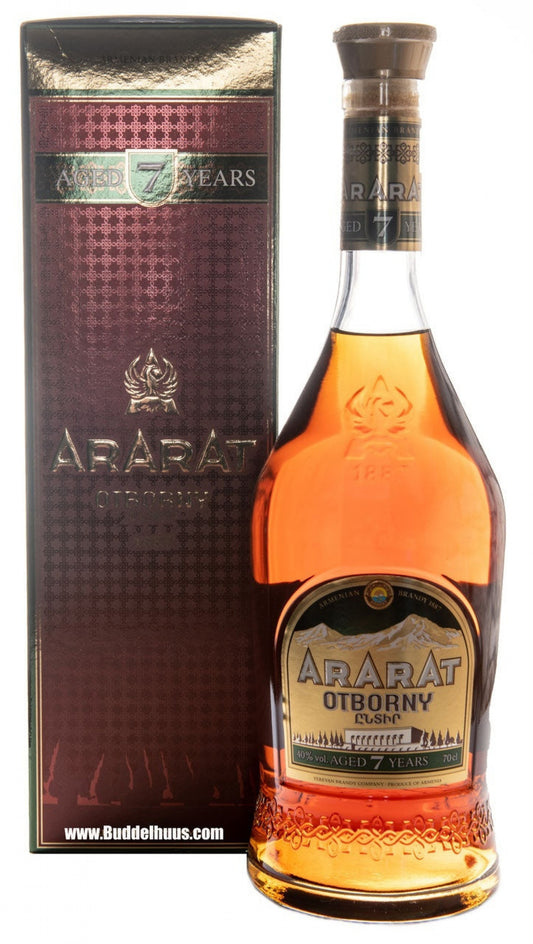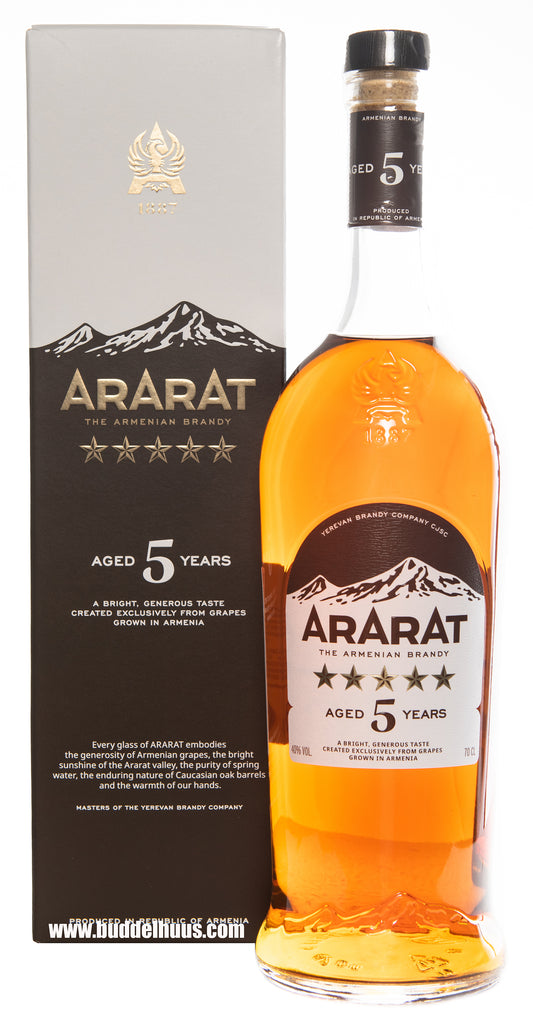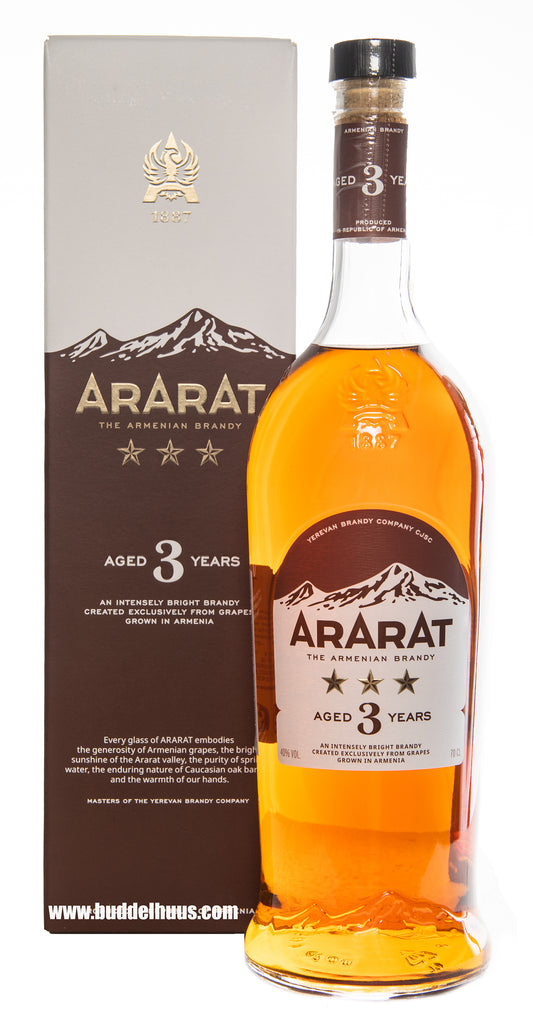-
Ararat 7 yo Otborny
Regular price CHF 27.00Regular priceUnit price per
-
Ararat 5*
Regular price CHF 22.50Regular priceUnit price per
-
Ararat 3*
Regular price CHF 22.50Regular priceUnit price per
Brandy and grape brandies have been among the most internationally popular and widely distributed spirits for centuries. Distilled from different grape varieties, various brands and their individual products offer unique flavors. Brandy and grape brandy are traditionally enjoyed either neat or mixed with cola. Furthermore, these spirits impart a distinctive flavor to a variety of well-known cocktails.
E A brief history of grape brandy Grape brandy
Known as Brandy in many countries, is a high-proof distillate made entirely from wine. Grape brandy and grape distillates are among the oldest known spirits globally. Historical evidence suggests that high-proof distillates from wine were already produced in the region now known as Turkey around 1,000 AD. However, it wasn't until the Middle Ages that grape brandies spread to Europe. Initially, grape brandy in Europe was not known as a beverage for enjoyment but rather was used for medicinal purposes. Cognac, specifically, is said to have been invented by Chevalier de la Croix-Maron, an ancestor of the French noble family Castelbajac. Grape brandy from France was exported to other European countries and overseas in the 17th century.
Origin of the name "brandy"
In Middle Low German, grape brandy was originally called "brandewin." From this, the English term "brandy wine" emerged, which was later shortened to "brandy" and is still used today to refer to grape brandy. This applies not only to English-speaking countries but also to grape brandies from Italy, Spain, and international production. Until the early 20th century, grape brandies in Germany were commonly referred to as Cognac or Kognak. However, since the end of World War I, these terms are only allowed as sales designations if the grape brandy is actually produced in the Cognac region of France.
Brandy is not the same as spirits!
The terms "spirits" and "brandy" are often used synonymously, but this is not accurate. Officially, any distilled alcoholic beverage is called spirits, while grape brandy or brandy is always a distillate made from wine. However, it is considered a specific spirit category among those produced from various starchy and sugary raw materials, from a tax perspective.
Legal regulations regarding grape brandy
Relevant EU regulations define the characteristics that distinguish brandy or grape brandy. Among other requirements, these spirits must have a minimum alcohol content of 36% by volume, with the minimum content for German grape brandy set at 38% by volume. It is worth noting that the original distillate has an alcohol content of about 52 to 86 percent, which is then adjusted to drinking strength by the bottler before sale. Additionally, grape brandy must mature for at least six months in oak barrels, giving the spirit its typical amber to dark brown color. However, the color is not a quality indicator for these spirits, as, according to legal regulations, sugar and caramel color may be added. However, adding ethanol from other sources is prohibited. White grape brandies and fruit brandies, which must always be labeled with the fruit used and are considered liqueurs, do not fall under the category of grape brandies according to EU regulations.
Grape brandy: one drink, many countries of origin
Grape brandy is produced in almost all European countries where grapes are grown. Spain, Greece, France, and Germany are among the most significant producers of grape brandies. However, Italy and large parts of the former Yugoslavia also traditionally produce brandy. Countries not typically known for grape cultivation, such as Norway, are also significant producers of grape brandy. Moreover, overseas, countries like the United States, Chile, and Peru also produce brandies. In Switzerland, grape brandy production is not significant. Nevertheless, many Swiss people enjoy high-quality brandies from neighboring countries and overseas.
National characteristics of various grape brandies
Grape brandy production and grape brandy itself vary between countries in Europe and internationally. Differences are found mainly in nuances of the distillation process and, at times, the subsequent aging of the distillate.
Grape brandies from Germany
There are several well-known grape brandies from Germany, including Asbach Uralt and Chantré. However, a product can only be labeled as "Deutscher Weinbrand" (German grape brandy) if it has a minimum alcohol content of 38% by volume and is labeled with an official examination number. Chantré does not meet these criteria, as it has only 36% alcohol content and cannot be labeled as "Deutscher Weinbrand," despite being produced in Germany. Nevertheless, it has been among the top-selling spirits in Germany for years.
Grape brandies from France
France is known for its exquisite Cognacs, which are, of course, also considered grape brandies. However, due to naming regulations, only brandies distilled in the departments of Charente and Charente-Maritime can be called Cognac. Additionally, a genuine Cognac must age for at least 30 months in Limousin oak barrels and have a minimum alcohol content of 40% by volume.
French grape brandies from the Gascony region, known as Armagnacs, are also popular. Unlike Cognacs, Armagnacs are distilled in a single pass, while Cognac uses the double distillation process. Similar to Cognac, Armagnac is a protected geographical indication.
Brandies from Spain
Spain not only has the longest tradition of brandy production in Europe but is also the world's largest brandy producer. Traditionally, more than 90% of these brandies are distilled on the Spanish Atlantic coast in the Jerez de la Frontera region. "Brandy de Jerez" is, therefore, a protected geographical indication. This designation is the only one officially approved by the EU.
Spanish brandies are produced using a unique process. Spaniards always use two completely different distillates for their grape brandy, which are then blended. These are the Holandas and the Destilados. While the Holandas serve as the main carriers of the brandy's flavor, the Destilados are aromatically neutral, giving the brandy a lighter and milder taste.
Spanish brandy also differs significantly from products in other countries regarding maturation and aging. Initially, it is aged in American oak barrels previously used for maturing Sherry. Additionally, aging occurs in the up to twelve stages of the so-called Solera system, where brandies of different maturity levels are blended. Therefore, there are different quality levels for Spanish brandies. Solera must age for at least six months, while Solera Reserva has a minimum aging time of twelve months. Solera Gran Reserva, on the other hand, ages for a minimum of 36 months, typically much longer.
Brandy from Italy and Portugal
High-quality brandies have been produced in Portugal and Italy for many years. The most well-known grape brandy from Italy is likely Vecchia Romagna, which uses the same grape as Cognac as its base. It is typically available in two qualities in Switzerland: with three and ten years of aging in Limousin oak barrels. Among the most popular brandies from Portugal is Macieira, produced since 1885, which ages for at least six months in oak barrels before being bottled.



